ENT601 Entrepreneurship Case Study: Analysis of Jack Ma's Alibaba
VerifiedAdded on 2023/06/10
|23
|4223
|437
Case Study
AI Summary
This assignment comprises an individual case study analyzing Jack Ma's entrepreneurial journey with Alibaba Group, applying the Timmons FORT model to assess the opportunities, team dynamics, and resources that contributed to its success. It also includes a business concept analysis for a 'Prime Restaurant,' detailing the product description of an environment-friendly restaurant offering diverse cuisines, a business model canvas outlining key partners, activities, resources, and value propositions, market research identifying target customers, and basic financial projections evaluating the feasibility of the venture. The assignment concludes by highlighting key factors in launching and growing a successful venture, drawing lessons from Jack Ma's experiences and evaluating the potential of the proposed restaurant concept.

Running head: ENTREPRENEURSHIP
Entrepreneurship
Student’s name:
Name of the university:
Author’s note
Entrepreneurship
Student’s name:
Name of the university:
Author’s note
Paraphrase This Document
Need a fresh take? Get an instant paraphrase of this document with our AI Paraphraser
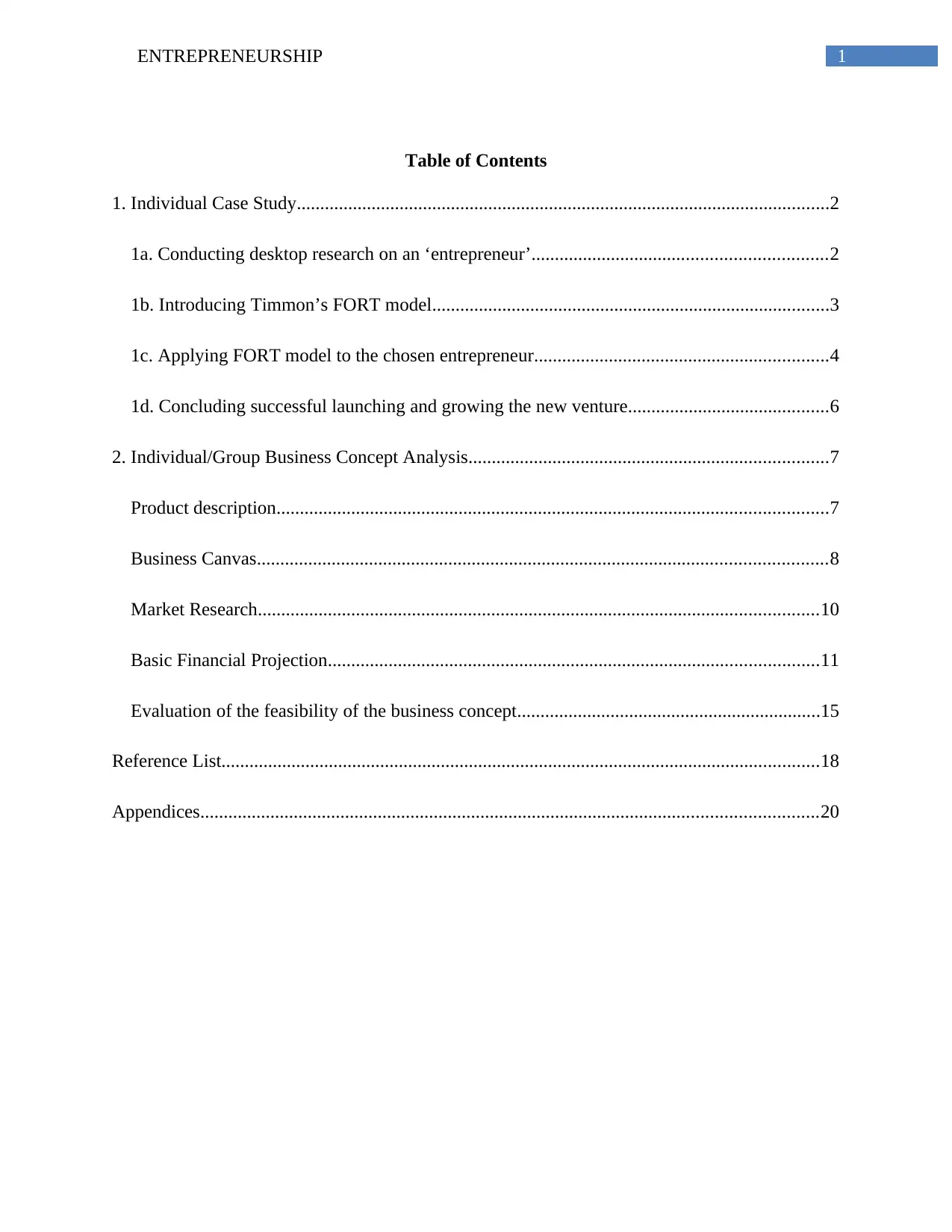
1ENTREPRENEURSHIP
Table of Contents
1. Individual Case Study..................................................................................................................2
1a. Conducting desktop research on an ‘entrepreneur’...............................................................2
1b. Introducing Timmon’s FORT model.....................................................................................3
1c. Applying FORT model to the chosen entrepreneur...............................................................4
1d. Concluding successful launching and growing the new venture...........................................6
2. Individual/Group Business Concept Analysis.............................................................................7
Product description......................................................................................................................7
Business Canvas..........................................................................................................................8
Market Research........................................................................................................................10
Basic Financial Projection.........................................................................................................11
Evaluation of the feasibility of the business concept.................................................................15
Reference List................................................................................................................................18
Appendices....................................................................................................................................20
Table of Contents
1. Individual Case Study..................................................................................................................2
1a. Conducting desktop research on an ‘entrepreneur’...............................................................2
1b. Introducing Timmon’s FORT model.....................................................................................3
1c. Applying FORT model to the chosen entrepreneur...............................................................4
1d. Concluding successful launching and growing the new venture...........................................6
2. Individual/Group Business Concept Analysis.............................................................................7
Product description......................................................................................................................7
Business Canvas..........................................................................................................................8
Market Research........................................................................................................................10
Basic Financial Projection.........................................................................................................11
Evaluation of the feasibility of the business concept.................................................................15
Reference List................................................................................................................................18
Appendices....................................................................................................................................20

2ENTREPRENEURSHIP
1. Individual Case Study
1a. Conducting desktop research on an ‘entrepreneur’
Ma Yun; professionally known as Jack Ma is one of the successful entrepreneurs of
recent time. Jack Ma is a Chinese entrepreneur and he is the co-founder of Alibaba Group. In
trade, Ma has worth estimated of $42 billion and it includes almost 7.8% of the stake of Alibaba
(Kim et al. 2017). Alibaba Group is famous e-commerce group in China. Jack Ma grew up in
communist China and Ma was rejected from many job interviews and Alibaba was his third
internet business attempt.
Jack Ma was born in 1964 in Hangzhou and it is in the South-eastern part of China. Jack
Ma has a younger sister and an elder brother. His family did not have much money. Ma lived in a
place which is the hometown of tourists and Ma learnt English from there. Ma failed in the
university-entrance exam twice, he finally passed the exam on the third try. He went to attend
Hangzhou Teachers Institute and he graduated in the year 1988. After getting maximum
rejections; he was hired as an English teacher. First Ma Started a translation business and he tried
to assist a Chinese firm to recover the payment. His first two attempts failed and he assembled 17
of his friends in the apartment to start an online marketplace. This ‘Alibaba' site allowed the
exporters to post about product listing. In the year 1999, his online platform gathered the funding
of $25 million and Yahoo also invested $1 billion in Alibaba venture (Tan et al. 2017). Revenue
of Alibaba Group at present reached Yen 250 billion and Alibaba Group provides the services
and products like an online auction, mobile commerce, e-commerce, online money transfer and
online shopping.
[Refer to Appendix 1 and 2]
1. Individual Case Study
1a. Conducting desktop research on an ‘entrepreneur’
Ma Yun; professionally known as Jack Ma is one of the successful entrepreneurs of
recent time. Jack Ma is a Chinese entrepreneur and he is the co-founder of Alibaba Group. In
trade, Ma has worth estimated of $42 billion and it includes almost 7.8% of the stake of Alibaba
(Kim et al. 2017). Alibaba Group is famous e-commerce group in China. Jack Ma grew up in
communist China and Ma was rejected from many job interviews and Alibaba was his third
internet business attempt.
Jack Ma was born in 1964 in Hangzhou and it is in the South-eastern part of China. Jack
Ma has a younger sister and an elder brother. His family did not have much money. Ma lived in a
place which is the hometown of tourists and Ma learnt English from there. Ma failed in the
university-entrance exam twice, he finally passed the exam on the third try. He went to attend
Hangzhou Teachers Institute and he graduated in the year 1988. After getting maximum
rejections; he was hired as an English teacher. First Ma Started a translation business and he tried
to assist a Chinese firm to recover the payment. His first two attempts failed and he assembled 17
of his friends in the apartment to start an online marketplace. This ‘Alibaba' site allowed the
exporters to post about product listing. In the year 1999, his online platform gathered the funding
of $25 million and Yahoo also invested $1 billion in Alibaba venture (Tan et al. 2017). Revenue
of Alibaba Group at present reached Yen 250 billion and Alibaba Group provides the services
and products like an online auction, mobile commerce, e-commerce, online money transfer and
online shopping.
[Refer to Appendix 1 and 2]
⊘ This is a preview!⊘
Do you want full access?
Subscribe today to unlock all pages.

Trusted by 1+ million students worldwide
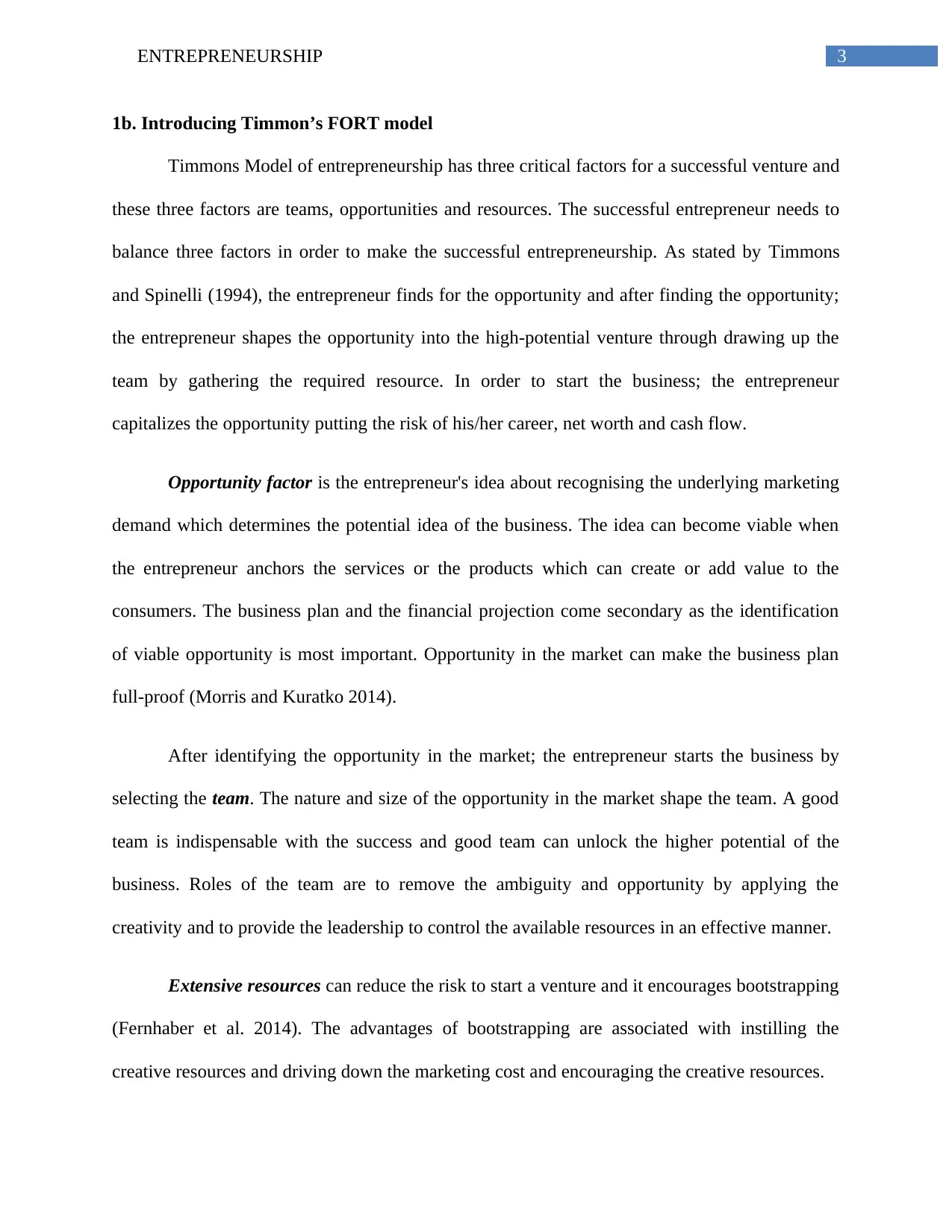
3ENTREPRENEURSHIP
1b. Introducing Timmon’s FORT model
Timmons Model of entrepreneurship has three critical factors for a successful venture and
these three factors are teams, opportunities and resources. The successful entrepreneur needs to
balance three factors in order to make the successful entrepreneurship. As stated by Timmons
and Spinelli (1994), the entrepreneur finds for the opportunity and after finding the opportunity;
the entrepreneur shapes the opportunity into the high-potential venture through drawing up the
team by gathering the required resource. In order to start the business; the entrepreneur
capitalizes the opportunity putting the risk of his/her career, net worth and cash flow.
Opportunity factor is the entrepreneur's idea about recognising the underlying marketing
demand which determines the potential idea of the business. The idea can become viable when
the entrepreneur anchors the services or the products which can create or add value to the
consumers. The business plan and the financial projection come secondary as the identification
of viable opportunity is most important. Opportunity in the market can make the business plan
full-proof (Morris and Kuratko 2014).
After identifying the opportunity in the market; the entrepreneur starts the business by
selecting the team. The nature and size of the opportunity in the market shape the team. A good
team is indispensable with the success and good team can unlock the higher potential of the
business. Roles of the team are to remove the ambiguity and opportunity by applying the
creativity and to provide the leadership to control the available resources in an effective manner.
Extensive resources can reduce the risk to start a venture and it encourages bootstrapping
(Fernhaber et al. 2014). The advantages of bootstrapping are associated with instilling the
creative resources and driving down the marketing cost and encouraging the creative resources.
1b. Introducing Timmon’s FORT model
Timmons Model of entrepreneurship has three critical factors for a successful venture and
these three factors are teams, opportunities and resources. The successful entrepreneur needs to
balance three factors in order to make the successful entrepreneurship. As stated by Timmons
and Spinelli (1994), the entrepreneur finds for the opportunity and after finding the opportunity;
the entrepreneur shapes the opportunity into the high-potential venture through drawing up the
team by gathering the required resource. In order to start the business; the entrepreneur
capitalizes the opportunity putting the risk of his/her career, net worth and cash flow.
Opportunity factor is the entrepreneur's idea about recognising the underlying marketing
demand which determines the potential idea of the business. The idea can become viable when
the entrepreneur anchors the services or the products which can create or add value to the
consumers. The business plan and the financial projection come secondary as the identification
of viable opportunity is most important. Opportunity in the market can make the business plan
full-proof (Morris and Kuratko 2014).
After identifying the opportunity in the market; the entrepreneur starts the business by
selecting the team. The nature and size of the opportunity in the market shape the team. A good
team is indispensable with the success and good team can unlock the higher potential of the
business. Roles of the team are to remove the ambiguity and opportunity by applying the
creativity and to provide the leadership to control the available resources in an effective manner.
Extensive resources can reduce the risk to start a venture and it encourages bootstrapping
(Fernhaber et al. 2014). The advantages of bootstrapping are associated with instilling the
creative resources and driving down the marketing cost and encouraging the creative resources.
Paraphrase This Document
Need a fresh take? Get an instant paraphrase of this document with our AI Paraphraser
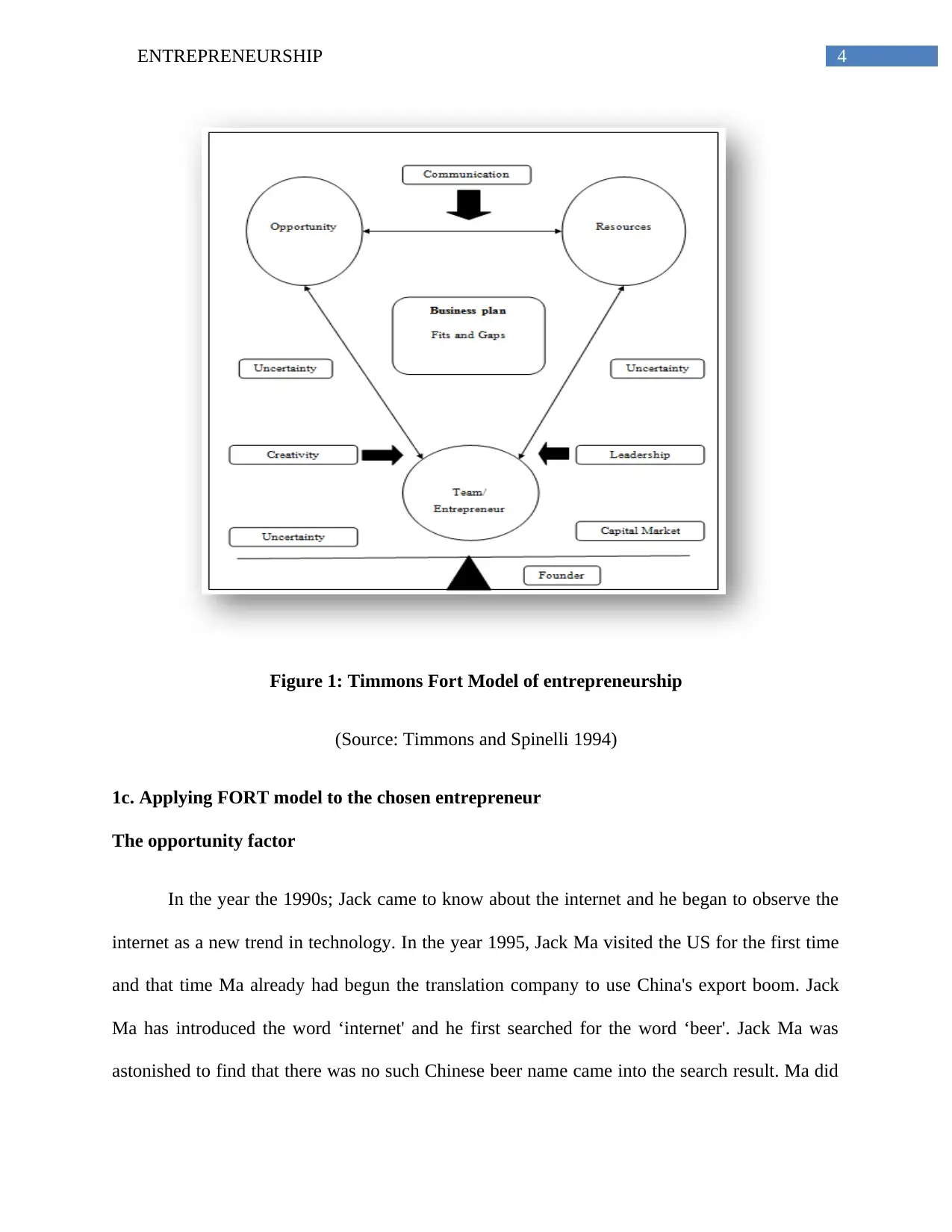
4ENTREPRENEURSHIP
Figure 1: Timmons Fort Model of entrepreneurship
(Source: Timmons and Spinelli 1994)
1c. Applying FORT model to the chosen entrepreneur
The opportunity factor
In the year the 1990s; Jack came to know about the internet and he began to observe the
internet as a new trend in technology. In the year 1995, Jack Ma visited the US for the first time
and that time Ma already had begun the translation company to use China's export boom. Jack
Ma has introduced the word ‘internet' and he first searched for the word ‘beer'. Jack Ma was
astonished to find that there was no such Chinese beer name came into the search result. Ma did
Figure 1: Timmons Fort Model of entrepreneurship
(Source: Timmons and Spinelli 1994)
1c. Applying FORT model to the chosen entrepreneur
The opportunity factor
In the year the 1990s; Jack came to know about the internet and he began to observe the
internet as a new trend in technology. In the year 1995, Jack Ma visited the US for the first time
and that time Ma already had begun the translation company to use China's export boom. Jack
Ma has introduced the word ‘internet' and he first searched for the word ‘beer'. Jack Ma was
astonished to find that there was no such Chinese beer name came into the search result. Ma did
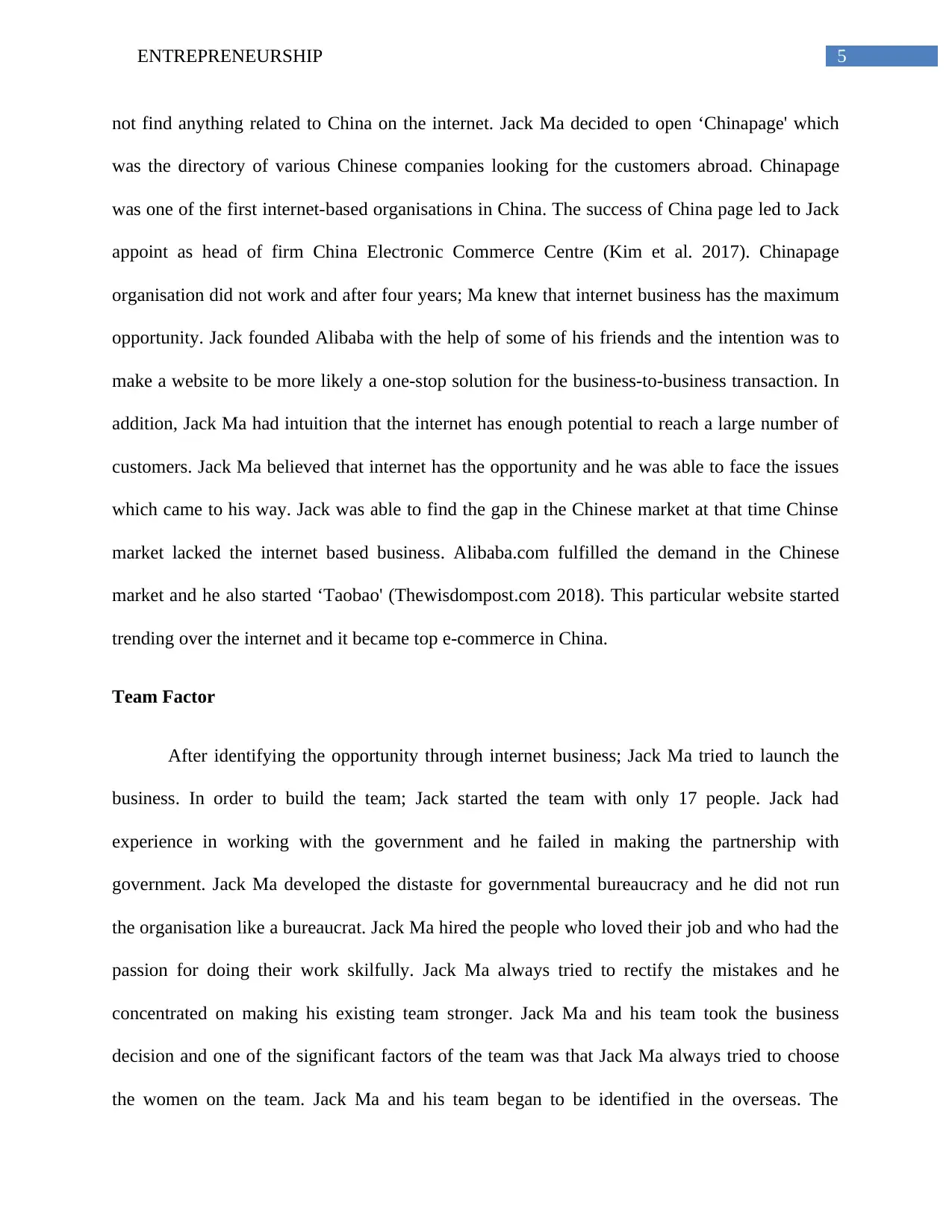
5ENTREPRENEURSHIP
not find anything related to China on the internet. Jack Ma decided to open ‘Chinapage' which
was the directory of various Chinese companies looking for the customers abroad. Chinapage
was one of the first internet-based organisations in China. The success of China page led to Jack
appoint as head of firm China Electronic Commerce Centre (Kim et al. 2017). Chinapage
organisation did not work and after four years; Ma knew that internet business has the maximum
opportunity. Jack founded Alibaba with the help of some of his friends and the intention was to
make a website to be more likely a one-stop solution for the business-to-business transaction. In
addition, Jack Ma had intuition that the internet has enough potential to reach a large number of
customers. Jack Ma believed that internet has the opportunity and he was able to face the issues
which came to his way. Jack was able to find the gap in the Chinese market at that time Chinse
market lacked the internet based business. Alibaba.com fulfilled the demand in the Chinese
market and he also started ‘Taobao' (Thewisdompost.com 2018). This particular website started
trending over the internet and it became top e-commerce in China.
Team Factor
After identifying the opportunity through internet business; Jack Ma tried to launch the
business. In order to build the team; Jack started the team with only 17 people. Jack had
experience in working with the government and he failed in making the partnership with
government. Jack Ma developed the distaste for governmental bureaucracy and he did not run
the organisation like a bureaucrat. Jack Ma hired the people who loved their job and who had the
passion for doing their work skilfully. Jack Ma always tried to rectify the mistakes and he
concentrated on making his existing team stronger. Jack Ma and his team took the business
decision and one of the significant factors of the team was that Jack Ma always tried to choose
the women on the team. Jack Ma and his team began to be identified in the overseas. The
not find anything related to China on the internet. Jack Ma decided to open ‘Chinapage' which
was the directory of various Chinese companies looking for the customers abroad. Chinapage
was one of the first internet-based organisations in China. The success of China page led to Jack
appoint as head of firm China Electronic Commerce Centre (Kim et al. 2017). Chinapage
organisation did not work and after four years; Ma knew that internet business has the maximum
opportunity. Jack founded Alibaba with the help of some of his friends and the intention was to
make a website to be more likely a one-stop solution for the business-to-business transaction. In
addition, Jack Ma had intuition that the internet has enough potential to reach a large number of
customers. Jack Ma believed that internet has the opportunity and he was able to face the issues
which came to his way. Jack was able to find the gap in the Chinese market at that time Chinse
market lacked the internet based business. Alibaba.com fulfilled the demand in the Chinese
market and he also started ‘Taobao' (Thewisdompost.com 2018). This particular website started
trending over the internet and it became top e-commerce in China.
Team Factor
After identifying the opportunity through internet business; Jack Ma tried to launch the
business. In order to build the team; Jack started the team with only 17 people. Jack had
experience in working with the government and he failed in making the partnership with
government. Jack Ma developed the distaste for governmental bureaucracy and he did not run
the organisation like a bureaucrat. Jack Ma hired the people who loved their job and who had the
passion for doing their work skilfully. Jack Ma always tried to rectify the mistakes and he
concentrated on making his existing team stronger. Jack Ma and his team took the business
decision and one of the significant factors of the team was that Jack Ma always tried to choose
the women on the team. Jack Ma and his team began to be identified in the overseas. The
⊘ This is a preview!⊘
Do you want full access?
Subscribe today to unlock all pages.

Trusted by 1+ million students worldwide

6ENTREPRENEURSHIP
company received funding from overseas business organisations as well. As stated by Feldman et
al. (2014), software engineers made the software and he trusts his team to make empower of the
organisation, it is one of the leadership functions of the organisation. Jack Ma wanted to know at
the initial stage that it is very difficult for an organisation to pull everyone's head in the same
direction.
Resource Factor
Resources of the organisation must be creative and it can provide stingy strategies to gain
control over the resources. The discipline of leanness in resources can lead towards the capital
efficiency of the organisation (Mauer et al. 2017). Jack Ma in the early stages attempted to raise
funds in Silicon Valley and he was unsuccessful and he was criticised for using this business
model. However, Jack Ma had succeeded in attracting Goldman Sachs to invest $5 million and
SoftBank of Japan also invested $20 million in Alibaba (Thewisdompost.com 2018). However,
the resources Alibaba are the funding, teamwork, the CEO and the technological support.
Alibaba went unprofitable till the time of 2003 and Ma launched the online auction business
named ‘Taobao.com'. In order to keep afloat in the Chinese economy, Ma and his team provided
the peripheral value-added support services (Scarborough 2016). Alibaba.com uses the unique
business model as it has three core businesses (YiDaTong, Taobao and 1688). According to Zhao
(2016), Alibaba has unconventional profit model as the maximum profit of Alibaba Group comes
from the keyword bidding, advertisement and it represents 57% of the total profits.
1d. Concluding successful launching and growing the new venture
It has been concluded that Jack Ma has been living in the future and he has a voracious
craving to increase the present circumstance of his life. Jack Ma is an ace communicator and he
company received funding from overseas business organisations as well. As stated by Feldman et
al. (2014), software engineers made the software and he trusts his team to make empower of the
organisation, it is one of the leadership functions of the organisation. Jack Ma wanted to know at
the initial stage that it is very difficult for an organisation to pull everyone's head in the same
direction.
Resource Factor
Resources of the organisation must be creative and it can provide stingy strategies to gain
control over the resources. The discipline of leanness in resources can lead towards the capital
efficiency of the organisation (Mauer et al. 2017). Jack Ma in the early stages attempted to raise
funds in Silicon Valley and he was unsuccessful and he was criticised for using this business
model. However, Jack Ma had succeeded in attracting Goldman Sachs to invest $5 million and
SoftBank of Japan also invested $20 million in Alibaba (Thewisdompost.com 2018). However,
the resources Alibaba are the funding, teamwork, the CEO and the technological support.
Alibaba went unprofitable till the time of 2003 and Ma launched the online auction business
named ‘Taobao.com'. In order to keep afloat in the Chinese economy, Ma and his team provided
the peripheral value-added support services (Scarborough 2016). Alibaba.com uses the unique
business model as it has three core businesses (YiDaTong, Taobao and 1688). According to Zhao
(2016), Alibaba has unconventional profit model as the maximum profit of Alibaba Group comes
from the keyword bidding, advertisement and it represents 57% of the total profits.
1d. Concluding successful launching and growing the new venture
It has been concluded that Jack Ma has been living in the future and he has a voracious
craving to increase the present circumstance of his life. Jack Ma is an ace communicator and he
Paraphrase This Document
Need a fresh take? Get an instant paraphrase of this document with our AI Paraphraser

7ENTREPRENEURSHIP
is a perfect business person. Jack Ma identified the importance and capability of the internet and
he united the team under the single goal. Changing the approach is another key to grab the
success rather than the uniting the company under the vision of one person. Jack Ma has the
foresight to develop the business and he had creative thinking skills. One of the most important
factors for the success of Jack Ma was that he hired the employees with superior skills which
helped Ma to carry out the important pillar of a great company. The venture of Alibaba was
successful; however, he tasted failure twice before and like other leaders, he learnt most from the
hardships and obstacles. Successful launching of the business was possible as Ma does not find
competitors as his enemies. The perfect combination of the team working good set of resources
and he identified the right gap in the market. Jack Ma built his empire in the rapidly developing
world and his venture has the potential to achieve more.
2. Individual/Group Business Concept Analysis
Product description
The green restaurant is a new concept as this type of restaurant is environment-friendly.
Prime Restaurant will be an environment-friendly restaurant which will offer Chinese, Indian
and Continental food items. Prime Restaurant is going to be an upscale restaurant which will
offer both rooftop seating and interior seating facility. Interior seating will have a touch of green
and the rooftop will also have a slight touch of green and grass. Apart from the soothing
atmosphere, the restaurant will have perfect waste management; energy efficient appliances,
recycled paper goods and the kitchen chimney will be furnished in a perfect way so that it may
not emit harmful gas. The supply chain of the restaurant will be environment-friendly and
is a perfect business person. Jack Ma identified the importance and capability of the internet and
he united the team under the single goal. Changing the approach is another key to grab the
success rather than the uniting the company under the vision of one person. Jack Ma has the
foresight to develop the business and he had creative thinking skills. One of the most important
factors for the success of Jack Ma was that he hired the employees with superior skills which
helped Ma to carry out the important pillar of a great company. The venture of Alibaba was
successful; however, he tasted failure twice before and like other leaders, he learnt most from the
hardships and obstacles. Successful launching of the business was possible as Ma does not find
competitors as his enemies. The perfect combination of the team working good set of resources
and he identified the right gap in the market. Jack Ma built his empire in the rapidly developing
world and his venture has the potential to achieve more.
2. Individual/Group Business Concept Analysis
Product description
The green restaurant is a new concept as this type of restaurant is environment-friendly.
Prime Restaurant will be an environment-friendly restaurant which will offer Chinese, Indian
and Continental food items. Prime Restaurant is going to be an upscale restaurant which will
offer both rooftop seating and interior seating facility. Interior seating will have a touch of green
and the rooftop will also have a slight touch of green and grass. Apart from the soothing
atmosphere, the restaurant will have perfect waste management; energy efficient appliances,
recycled paper goods and the kitchen chimney will be furnished in a perfect way so that it may
not emit harmful gas. The supply chain of the restaurant will be environment-friendly and
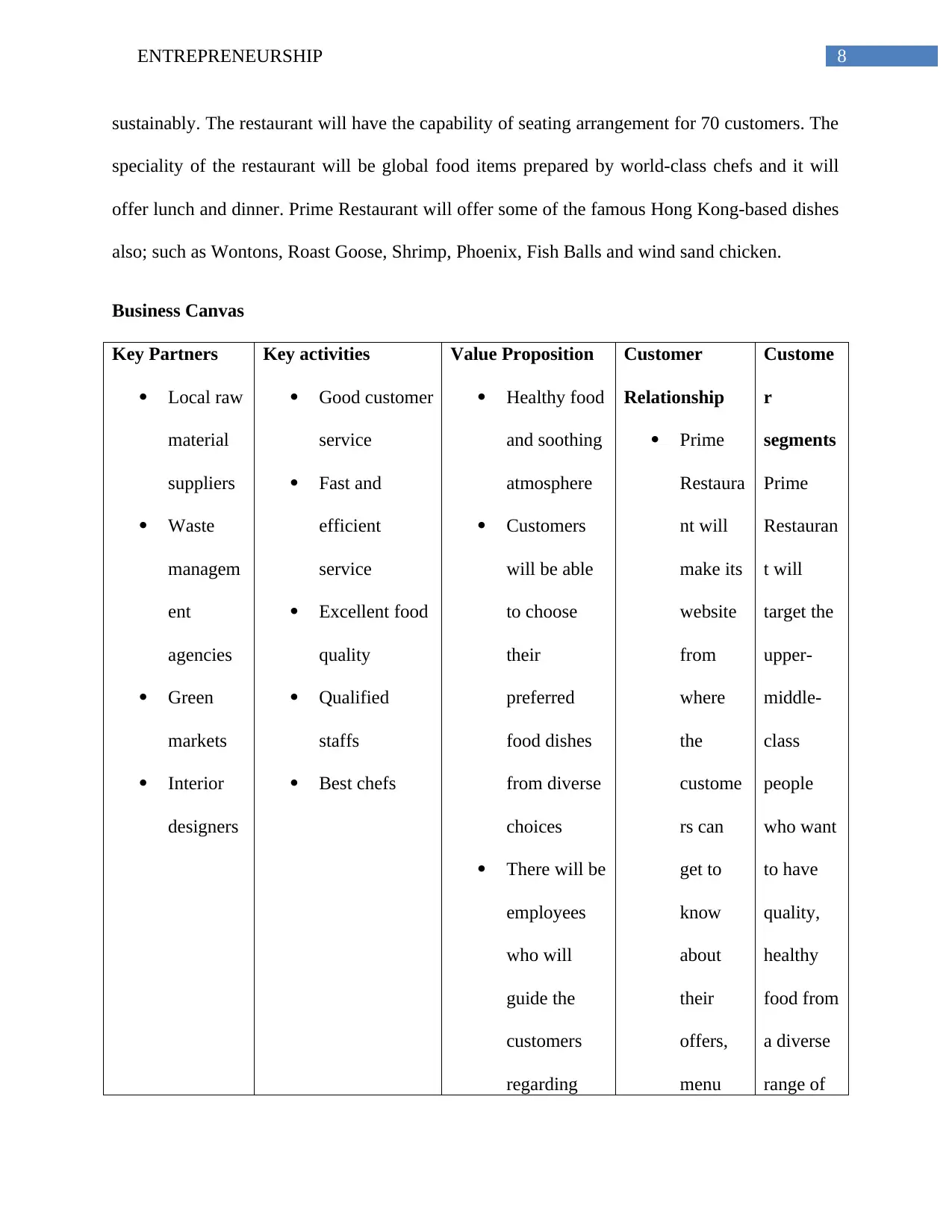
8ENTREPRENEURSHIP
sustainably. The restaurant will have the capability of seating arrangement for 70 customers. The
speciality of the restaurant will be global food items prepared by world-class chefs and it will
offer lunch and dinner. Prime Restaurant will offer some of the famous Hong Kong-based dishes
also; such as Wontons, Roast Goose, Shrimp, Phoenix, Fish Balls and wind sand chicken.
Business Canvas
Key Partners
Local raw
material
suppliers
Waste
managem
ent
agencies
Green
markets
Interior
designers
Key activities
Good customer
service
Fast and
efficient
service
Excellent food
quality
Qualified
staffs
Best chefs
Value Proposition
Healthy food
and soothing
atmosphere
Customers
will be able
to choose
their
preferred
food dishes
from diverse
choices
There will be
employees
who will
guide the
customers
regarding
Customer
Relationship
Prime
Restaura
nt will
make its
website
from
where
the
custome
rs can
get to
know
about
their
offers,
menu
Custome
r
segments
Prime
Restauran
t will
target the
upper-
middle-
class
people
who want
to have
quality,
healthy
food from
a diverse
range of
sustainably. The restaurant will have the capability of seating arrangement for 70 customers. The
speciality of the restaurant will be global food items prepared by world-class chefs and it will
offer lunch and dinner. Prime Restaurant will offer some of the famous Hong Kong-based dishes
also; such as Wontons, Roast Goose, Shrimp, Phoenix, Fish Balls and wind sand chicken.
Business Canvas
Key Partners
Local raw
material
suppliers
Waste
managem
ent
agencies
Green
markets
Interior
designers
Key activities
Good customer
service
Fast and
efficient
service
Excellent food
quality
Qualified
staffs
Best chefs
Value Proposition
Healthy food
and soothing
atmosphere
Customers
will be able
to choose
their
preferred
food dishes
from diverse
choices
There will be
employees
who will
guide the
customers
regarding
Customer
Relationship
Prime
Restaura
nt will
make its
website
from
where
the
custome
rs can
get to
know
about
their
offers,
menu
Custome
r
segments
Prime
Restauran
t will
target the
upper-
middle-
class
people
who want
to have
quality,
healthy
food from
a diverse
range of
⊘ This is a preview!⊘
Do you want full access?
Subscribe today to unlock all pages.

Trusted by 1+ million students worldwide
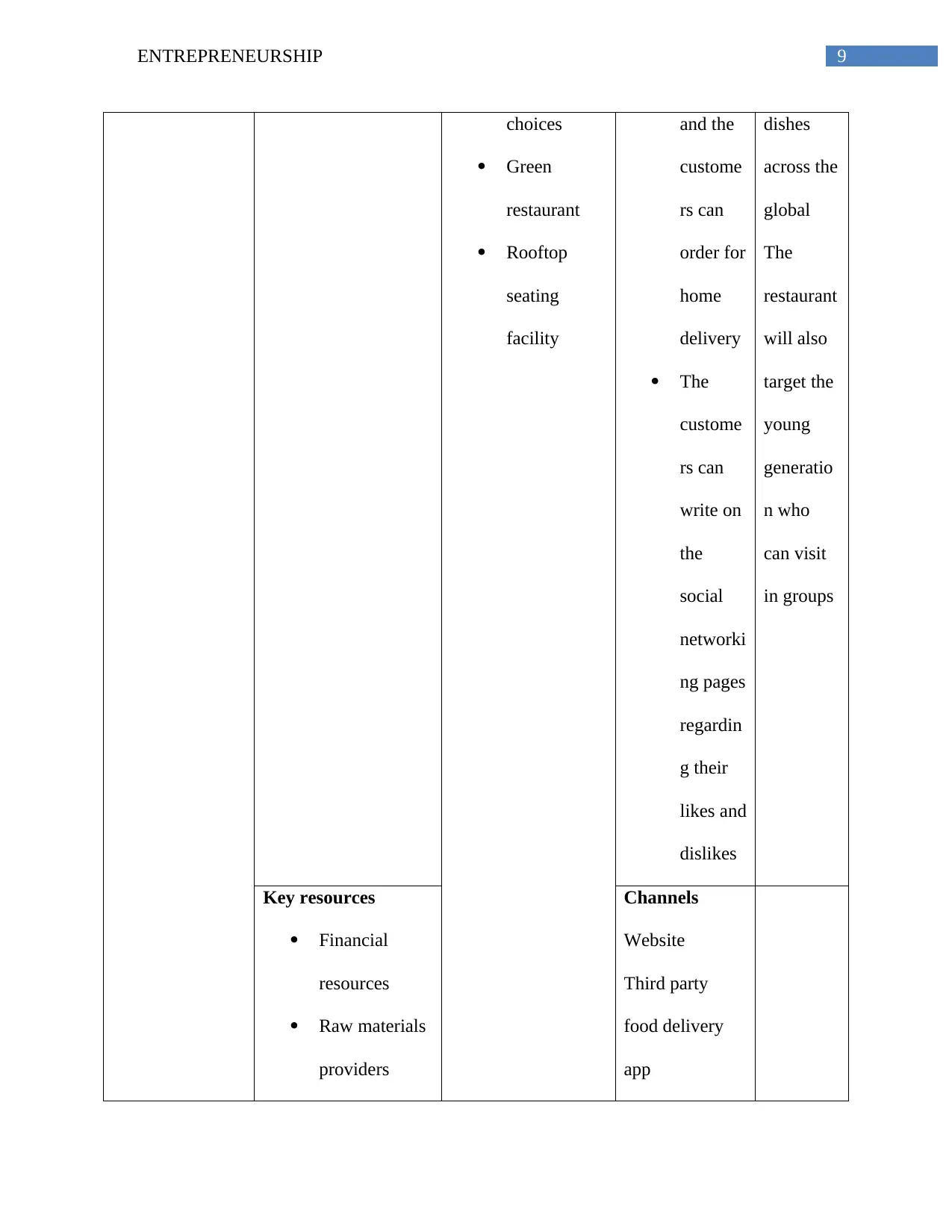
9ENTREPRENEURSHIP
choices
Green
restaurant
Rooftop
seating
facility
and the
custome
rs can
order for
home
delivery
The
custome
rs can
write on
the
social
networki
ng pages
regardin
g their
likes and
dislikes
dishes
across the
global
The
restaurant
will also
target the
young
generatio
n who
can visit
in groups
Key resources
Financial
resources
Raw materials
providers
Channels
Website
Third party
food delivery
app
choices
Green
restaurant
Rooftop
seating
facility
and the
custome
rs can
order for
home
delivery
The
custome
rs can
write on
the
social
networki
ng pages
regardin
g their
likes and
dislikes
dishes
across the
global
The
restaurant
will also
target the
young
generatio
n who
can visit
in groups
Key resources
Financial
resources
Raw materials
providers
Channels
Website
Third party
food delivery
app
Paraphrase This Document
Need a fresh take? Get an instant paraphrase of this document with our AI Paraphraser
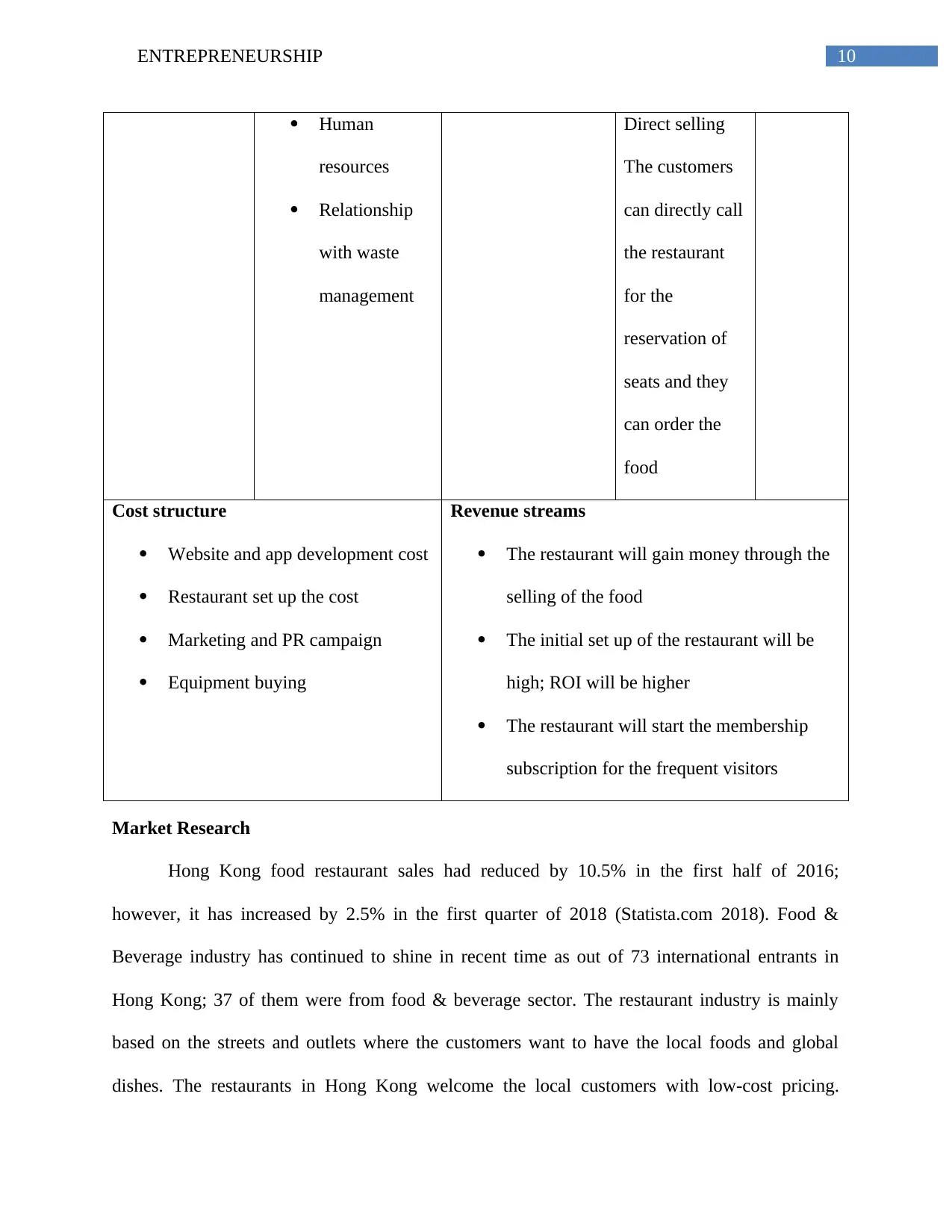
10ENTREPRENEURSHIP
Human
resources
Relationship
with waste
management
Direct selling
The customers
can directly call
the restaurant
for the
reservation of
seats and they
can order the
food
Cost structure
Website and app development cost
Restaurant set up the cost
Marketing and PR campaign
Equipment buying
Revenue streams
The restaurant will gain money through the
selling of the food
The initial set up of the restaurant will be
high; ROI will be higher
The restaurant will start the membership
subscription for the frequent visitors
Market Research
Hong Kong food restaurant sales had reduced by 10.5% in the first half of 2016;
however, it has increased by 2.5% in the first quarter of 2018 (Statista.com 2018). Food &
Beverage industry has continued to shine in recent time as out of 73 international entrants in
Hong Kong; 37 of them were from food & beverage sector. The restaurant industry is mainly
based on the streets and outlets where the customers want to have the local foods and global
dishes. The restaurants in Hong Kong welcome the local customers with low-cost pricing.
Human
resources
Relationship
with waste
management
Direct selling
The customers
can directly call
the restaurant
for the
reservation of
seats and they
can order the
food
Cost structure
Website and app development cost
Restaurant set up the cost
Marketing and PR campaign
Equipment buying
Revenue streams
The restaurant will gain money through the
selling of the food
The initial set up of the restaurant will be
high; ROI will be higher
The restaurant will start the membership
subscription for the frequent visitors
Market Research
Hong Kong food restaurant sales had reduced by 10.5% in the first half of 2016;
however, it has increased by 2.5% in the first quarter of 2018 (Statista.com 2018). Food &
Beverage industry has continued to shine in recent time as out of 73 international entrants in
Hong Kong; 37 of them were from food & beverage sector. The restaurant industry is mainly
based on the streets and outlets where the customers want to have the local foods and global
dishes. The restaurants in Hong Kong welcome the local customers with low-cost pricing.

11ENTREPRENEURSHIP
Tourists' visits are large in Hong Kong and local street foods are famous among the tourists.
Burgers and beers are famous among the international travellers and with people opting the fast
food over the fine dining. However, wealthy local customers and the tourists find the fine dining
options with rich atmosphere; the customers also find more innovative menus and promotions
from the restaurant. Sales revenue in restaurant and catering industry in Hong Kong is 113.4
Hong Kong dollars in 2018 and sales revenue of the restaurant industry would reach 123 billion
in Hong Kong dollars in 2019 (Smart 2017).
Basic Financial Projection
2019 2020
Gross revenue $4,125,000 $4,207,500
Cost of goods sold $320,000 $326,400
Gross margin $3,805,000 $3,881,100
Other revenue [source] $100,000 $100,000
Interest income $0 $0
Total revenue $3,905,000 $3,981,100
Operating expenses
Sales and marketing $80,000 $81,600
Payroll and payroll taxes $100,000 $102,000
Depreciation $153,000 $156,060
Maintenance, repair, and overhaul $0 $0
Tourists' visits are large in Hong Kong and local street foods are famous among the tourists.
Burgers and beers are famous among the international travellers and with people opting the fast
food over the fine dining. However, wealthy local customers and the tourists find the fine dining
options with rich atmosphere; the customers also find more innovative menus and promotions
from the restaurant. Sales revenue in restaurant and catering industry in Hong Kong is 113.4
Hong Kong dollars in 2018 and sales revenue of the restaurant industry would reach 123 billion
in Hong Kong dollars in 2019 (Smart 2017).
Basic Financial Projection
2019 2020
Gross revenue $4,125,000 $4,207,500
Cost of goods sold $320,000 $326,400
Gross margin $3,805,000 $3,881,100
Other revenue [source] $100,000 $100,000
Interest income $0 $0
Total revenue $3,905,000 $3,981,100
Operating expenses
Sales and marketing $80,000 $81,600
Payroll and payroll taxes $100,000 $102,000
Depreciation $153,000 $156,060
Maintenance, repair, and overhaul $0 $0
⊘ This is a preview!⊘
Do you want full access?
Subscribe today to unlock all pages.

Trusted by 1+ million students worldwide
1 out of 23
Related Documents
Your All-in-One AI-Powered Toolkit for Academic Success.
+13062052269
info@desklib.com
Available 24*7 on WhatsApp / Email
![[object Object]](/_next/static/media/star-bottom.7253800d.svg)
Unlock your academic potential
Copyright © 2020–2026 A2Z Services. All Rights Reserved. Developed and managed by ZUCOL.





